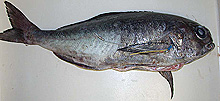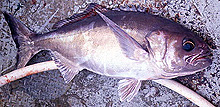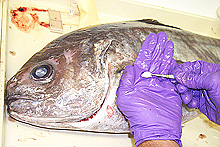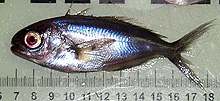
The American barrelfish (Hyperoglyphe perciformis) has eluded underwater sightings, so far. Click image for larger view.
The Elusive Barrelfish: An Enigma Wrapped in a Mystery . . .
Kelly Filer
Graduate Student
College of Charleston
The barrelfish has never actually been seen underwater, at least as an adult. This relatively large (35 in; 25 lb), deep-water fish is often caught by commercial fishermen off the coast of South Carolina around an area of rocky bottom called the Charleston Bump. The bump is home to many other species of fish (the commercially important wreckfish, for instance) and other animals, like squids, sponges, tunicates, and corals -- all readily visible to the underwater explorer. The barrelfish (Hyperoglyphe perciformis), however, remains elusive. No one who has explored the area in a submersible has been able to locate one.

A close relative of the barrelfish, the blue-eyed trevalla (Hyperoglyphe antarctica) lives in the Southern Hemisphere. The barrelfish may share some life history characteristics with the trevalla. Click image for larger view.
The Charleston Bump supports a diversity of marine life, because upwelling brings large amounts of nutrient from the bottom water to the shallower depths, where sunlight reaches phytoplankton. More nutrient leads to more phytoplankton, which means there is more food available, and, therefore, more animals can live in this region. Further, the complex habitat of sand, rocks, caves, and depressions provide shelters for a diverse fauna.
Interpreting clues
Apparently, the barrelfish lives at some distance above the bottom. We have
never actually observed this, but we can infer it from two facts. First,
the barrelfish has never been seen during any of the numerous submersible
dives to the bottom in the Charleston Bump area. Secondly, the area's fishermen
report catching this fish on baited hooks that are fished just off
the bottom. We do know that barrelfish juveniles are often
found in the surface waters near the northeastern U.S. (in areas
like Massachusetts Bay) during the summer months; and they are often seen
near floating debris, such as wood barrels (hence, their name).

This is the otolith (ear bone) of an American barrelfish. The structure contains rings, similar to the rings of a tree. By making a very thin section of a fish's otolith, and counting the rings, we can determine its age. Click image for larger view.
Adult barrelfish have also been caught in the Florida Straits and occasionally along the North American coast from Nova Scotia to the Florida Keys. They have been seen in the eastern North Atlantic around Ireland, Spain, and Portugal, and in the western Mediterranean Sea. Many of the records describe juveniles associated with floating debris.
The
pan-oceanic distribution of the species suggests that they may circle the North Atlantic during their life
cycle, perhaps drifting with debris in the North Atlantic subtropical gyre ![]() of which the Gulf Stream is a key component. We
believe the wreckfish and loggerhead sea turtle,
found around the Charleston Bump, also circumnavigate
the North Atlantic.
of which the Gulf Stream is a key component. We
believe the wreckfish and loggerhead sea turtle,
found around the Charleston Bump, also circumnavigate
the North Atlantic.
That is essentially all we know about the barrelfish, which is why we hope to observe them in their natural habitat during the manned submersible dives of this expedition. We will explore underwater areas where fishermen have reported barrelfish catches, hoping to see how and where they feed, which habitat(s) they prefer, and how they behave around other barrelfish (schooling vs. territorial) and other fish species.
A life history
Gaining knowledge about
barrelfish behavior and habitat preferences is a first step toward understanding
its life history: how old it gets, how big it is when it starts
to reproduce, and what time of the year it reproduces. It will also
help us understand the things that affect that life history, such as its
food sources, the oceanographic features of its habitat, and its interactions
with other species of organisms in the area.
During our exploration of the Blake Plateau, we will attempt to observe different sized barrelfish at different depths and to collect juveniles at the surface with dip nets and neuston nets. We hope our observations during this cruise will help us understand the life history of the barrelfish. Then we can begin to draft a fishery management plan that will allow us to enjoy these fish for many years to come.


























